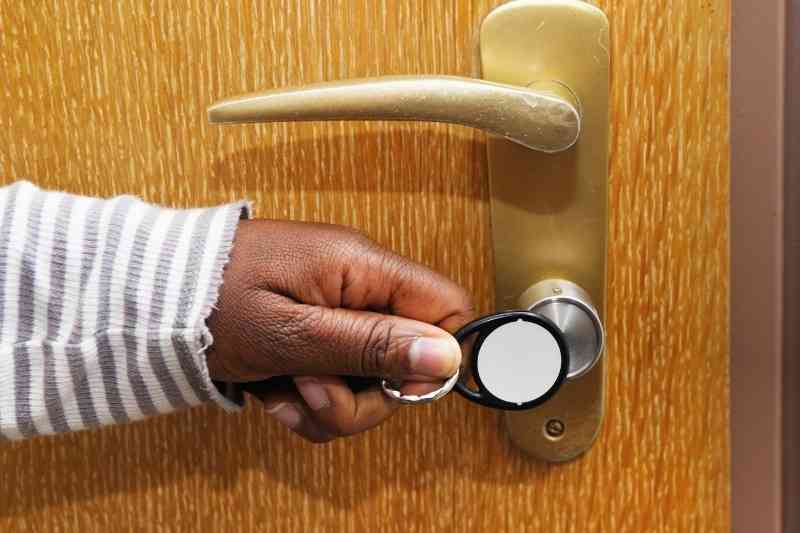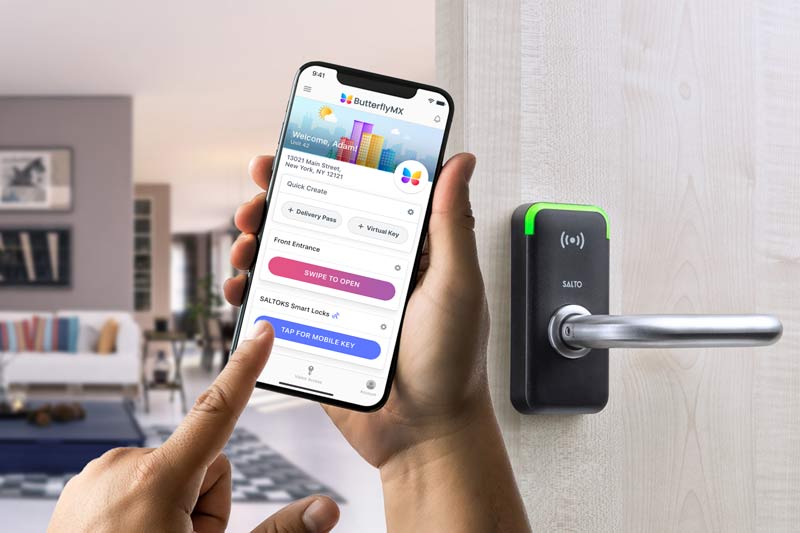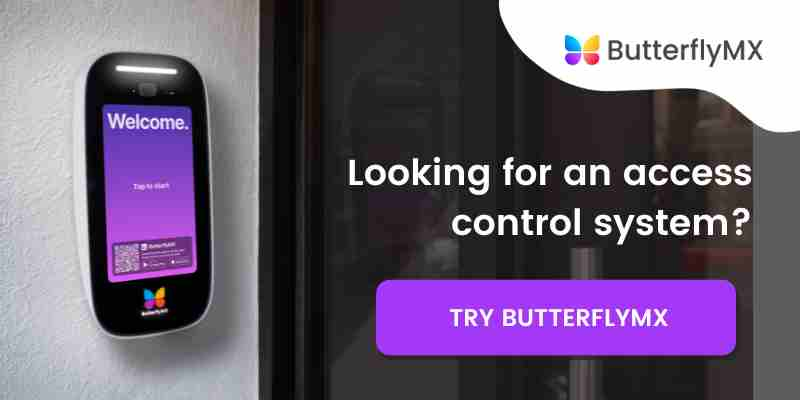Key takeaways
- RFID door locks get the job done when it comes to managing access to individual units for tenants with pre-authorized credentials. But because your property probably has shared amenity spaces and multiple entrances, you need a more robust access control system.
- Plus, both residential and commercial tenants welcome delivery couriers and other guests every day. So, an access solution that only benefits tenants is not enough.
- Instead, consider a unified solution of smart locks, keypads, and a smartphone-based video intercom.
- The right access control systems save you time and money by removing all the costs associated with issuing credentials — while giving residents the flexibility and tools to manage their own access experiences.

Managing a property is a delicate, complex task. Your tenants are counting on you to maintain the property’s security, but they also expect a quick and easy entry process. The right access control system will go a long way in helping you fulfill those needs. And RFID door locks may achieve those goals.
In this post, we explain what an RFID door lock is and how it works. Then, we go over the pros and cons of using RFID door locks, share the best RFID locks on the market, and offer alternative access control solutions.
This post covers:
- What is an RFID door lock?
- How do RFID door locks work?
- RFID door lock pros and cons
- Features to look for in an RFID lock
- 3 best RFID door locks
- Alternatives to RFID door locks
What is an RFID door lock?
An RFID door lock is a type of electronic lock that you access using credentials, like key fobs or key cards, that are powered by RFID technology.
RFID (radio frequency identification) technology uses electromagnetic fields to enable communication between two devices: tags and readers. Many industries use RFID technology. Logistics companies use it to monitor the progress of cars and airplanes, and even farmers have found a use for it — they use RFID tags to categorize and identify their cattle. As access control providers innovated past the traditional lock and key, they’ve also found the wireless capabilities and flexibility of RFID technology useful.
When it comes to RFID door lock installation, you can choose between a few different configurations. Some RFID door locks work with existing deadbolts, so you can use metal keys alongside RFID credentials. Other RFID locks replace the deadbolt entirely and only work with electronic credentials.
On a residential property, RFID locks might be installed on unit doors that lead into apartments or other doors that lead into amenity spaces like gyms or coworking rooms. RFID systems can also be used at commercial properties. A business, for example, might issue keycards to each employee to gain access to certain offices or rooms within the building.
RFID door locks require these 3 components to function:
- RFID tag. Also known as a transponder, an RFID tag is a tiny device that stores a string of unique, computerized data. This string of data verifies a resident’s identity. The RFID tag is built into a credential, usually a fob or card.
- Credential reader. Credential readers receive data from a credential and send it to a control panel. The most important component of a credential reader is an antenna, which allows it to communicate with the tag.
- Control panel. The control panel is the brain of the entire RFID door lock system. Control panels store a database holding all credential information, and decide whether a credential matches or not. Staff can also use the control panel to update access permissions and modify the database whenever a resident moves in or out.

How do RFID door locks work?
RFID door locks work by using radio waves to establish a connection between a credential and a reader. When a tenant presents their credential to the lock, the reader determines whether they have permission to access the room or building.
An RFID door lock system requires building administrators to program and assign a unique credential to each tenant. Admins must also deactivate credentials if a tenant loses theirs or moves out of the building.
RFID door locks are a type of wireless and electronic access control device that functions similarly to smart locks. However, the difference is that smart locks operate via an internet and/or Bluetooth connection, and tenants can unlock them with a smartphone. In contrast, RFID locks operate via radio waves and require tenants to use a physical device, like a plastic fob or key card.
Watch how ButterflyMX works:
Using an RFID door lock
Here’s what happens when someone uses an RFID door lock system:
- User holds credential up to reader. Depending on the specific type of RFID door lock you buy, a user might have to physically place their key or fob onto the reader. Other RFID systems are powerful enough to read credentials from a distance, making them valid for touchless entry.
- Reader and credential interact. The credential sends a string of unique data to the reader using radio waves.
- Control panel verifies user’s credentials. The control panel compares the data sent over by the reader to an internal database. If there’s a match, the control panel instructs the door to open.
- Control panel directs lock to disengage. The control panel sends an electric current to the lock, unlocking the door and allowing the person to enter.
Active vs. passive credentials
There are two types of credentials used by RFID door locks: active and passive.
An active credential is battery-powered. So, when it detects a nearby reader, it uses an internal power source to emit radio waves to the reader.
In contrast, passive credentials depend on readers to send electromagnetic energy. A passive credential reader continuously generates a low-energy electric field called an excite field. These excite fields power a passive reader, giving it enough energy to send out information.
So how does that difference affect users? Active credentials are more powerful and can engage the RFID reader from further away. However, because active credentials are battery-powered, they’ll need recharging or replacement. You’ll have to replace key cards or key fobs belonging to an active system at a higher rate than if you were using a passive system. Consider the needs of your property carefully before making your choice.

RFID door lock pros & cons
RFID door locks use technology to simplify access for residents. But do the benefits of RFID technology outweigh its disadvantages? And are RFID locks useful for property managers and staff? Read on to learn about the pros and cons of an RFID door lock.
RFID lock for door pros:
- Easy to replace credentials. You’ll certainly be issuing streams of new keys or fobs as new tenants move in or existing ones lose them. And unlike traditional metal keys, you can simply print out a new key card for a tenant using onsite equipment.
- Convenience for tenants. Using an RFID card or fob is much easier than fumbling around with a key. And because some RFID readers can read a tag without the user touching it, your health-conscious residents will also appreciate the benefits of contact-free door entry methods.
- Simple to administer. One RFID key card can be set to work with multiple doors within a building. For example, you can grant a resident access to their unit in addition to an indoor amenity, like a gym. You do this by programming one key for multiple rooms instead of creating separate key cards for each room.
RFID door lock cons:
- Credentials are easily lost. Unfortunately, like with brass keys, tenants frequently lose their RFID credentials. While residents might appreciate that a fob or key card is easier to use, the chances of losing them are quite high. And when that happens, residents must take time out of their busy schedules to replace the fob. Ultimately, this means that the convenience benefits for residents aren’t as significant as they might seem.
- Credentials are insecure. Can RFID door locks be hacked? Unfortunately, the answer is yes. Issuing RFID credentials is certainly easier than cutting traditional keys. However, a quick online search reveals that anyone can order their own RFID copying machine for less than $15 — increasing the potential for security breaches on your property.
- No way to manage visitor entry. Managing entry for visitors is one of the most important features of a modern access control system. From personal friends to dog walkers to delivery couriers, today’s residents are dealing with a constant stream of visitors. However, an RFID door lock doesn’t give residents a way to verify a guest’s identity or remotely grant a visitor entry. Although RFID door locks may be adequate for residents, they leave visitors out in the cold. In contrast, internet-powered smart locks allow users to send digital access codes and virtual keys to their trusted guests for easy access.
Features to look for in RFID locks
If you want to add RFID-powered locks to your building, make sure you choose the best locks that will boost convenience and security.
5 features to look for in RFID door locks:
Back-up access method
Quickly tapping an RFID card or key fob to unlock a door may be convenient. But what if someone forgets or loses their fob?
That’s why you need locks that offer a backup method of access.
Look for RFID door locks that have additional entry methods, like:
- Traditional key and keyhole
- Keypad to enter a PIN code
- Smartphone app
Time-based access
Sometimes, you want the ability to control when someone can access a building or room, not just who can access it.
For example, say you want to install an RFID lock on the door to your apartment gym. But the gym is only available from 6:00 am to 9:00 pm — you don’t want anyone to use it outside those hours.
In this case, RFID locks with time-based access empower you to set time constraints for each user’s access permissions.
Automatic locking
To maximize security, make sure the locks you install offer an auto-lock feature. This way, the door will automatically lock behind you after you exit or enter.
Consider the benefits of auto-locking when someone forgets to lock their door after leaving their apartment or amenity space. Everyone forgets to lock the door from time to time.
But auto-locking RFID locks will protect the space and assets within it. It also protects you, the building owner or manager, from liability and a huge headache in the event of an incident.
Mobile app
The best RFID door locks are also smart locks that pair with a mobile app, enabling users to manage access from their smartphones. Residents appreciate the convenience of using a mobile app to lock or unlock the door and send access codes to trusted visitors.
Integrations
Look for RFID locks that integrate with other property technologies, like access control systems and property management software. Lock providers with an open API may offer products that integrate with others to streamline and automate various processes.
Perhaps the most convenient integration an RFID lock can offer is with other access control devices, like intercom systems and keypad entry devices. When you integrate your locks with your building’s other access control technologies, you save a lot of time for the staff who manage all those devices. You also make it easier for tenants to use those devices from one handy app or platform.

3 best RFID door locks
Have you decided that RFID locks are right for your property? If so, choose the best models from the most reliable brands.
The 3 best RFID door locks include:
- SALTO KS XS4: SALTO is a trusted smart lock provider whose KS XS4 model offers RFID compatibility. The best part is it also integrates with other access control technologies.
- Lockly Secure Lux: The Lockly Secure Lux is the brand’s most advanced smart lock, offering more than just RFID-based access. You can also unlock doors with a fingerprint, Bluetooth, and a physical key.
- Prodigy SmartLock MaxSecure: Prodigy’s MaxSecure RFID lock is a rugged and durable option with an ANSI grade-2 certification. It also includes a traditional keyhole for backup access.

Alternatives to RFID door locks
It’s true that RFID door locks are a sophisticated option that might catch the eye of tech-savvy tenants. And it’s also true that RFID door locks have more conveniences and features than your standard metal lock and key.
But if you’re looking for an electronic access control solution, there are better options.
The best alternative to RFID door locks is an electronic access control system with three parts:
- Smartphone-based video intercom. A smartphone-based access control system is the most convenient option for both tenants and staff. Since residents can use their smartphones to open doors, your staff no longer have to bear the costs of constantly issuing and replacing RFID keys or fobs. Best of all, mobile access intercoms let tenants video chat with visitors before granting them access.
- Keypad. The best keypads are also smartphone-compatible. Install keypads to control access at secondary entrances, amenity rooms, and other shared spaces. Residents can open a keypad-controlled door by simply swiping on their phone. And they can also use their phones to generate and issue temporary PIN codes or virtual keys that make access simple for visitors.
- Smart locks. Install internet-powered smart locks on each unit door for a completely keyless access experience. Smart locks that pair with a mobile app are better than RFID door locks because they allow tenants to gain access with their smartphones and grant access to their trusted guests.

Learn more about ButterflyMX
Fill in the form below, and we'll email you right back.
Have questions?
Fill in the form below, and we'll email you right back.
